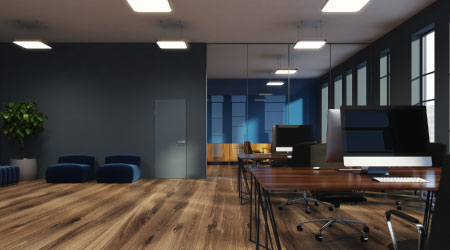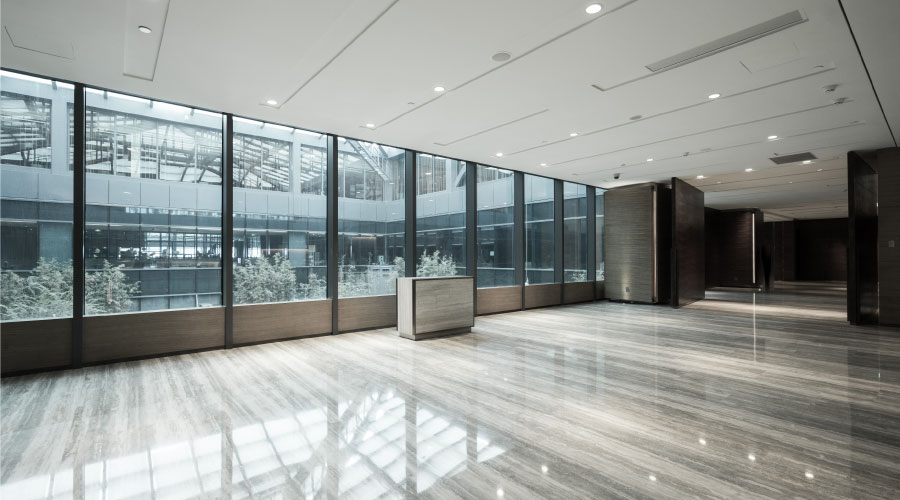Carpeting
Before buying carpet, compare choices carefully
Click here to view related Carpeting Products
A typical scenario when buying carpet goes like this: You meet a sales rep. The rep walks in with premium-branded products that meet specifications. The conversation turns to cost. You find out the budget is too small to get what you want.
The rep then pulls products more in line with the budget, along with assurances that the lesser-priced product is equal to the more expensive brand. You walk away thinking the product represents the best of both worlds.
After months of exorbitant maintenance costs and complaints about the ugly, worn carpet, it’s clear that making decisions solely on costs isn’t necessarily the best way to buy carpet.
“Some facility executives put the project out for bid and take the lowest cost,” says Lee Martin, vice president of sales for commercial carpet maker J & J Industries. “The results are usually less than desirable.”
Buying carpet and saving money starts with knowing what questions to ask and what answers to look for.
“One of the biggest mistakes people make is not understanding what they are buying,” says Marc Ahrens, regional and market segment manager for Antron, a carpet fiber manufacturer. “They think carpet is carpet, and they’ve just come to accept matting and crushing. It’s not a matter of poor performance; it’s a matter of having the wrong product. Correcting those mistakes means asking questions about fibers and backing.”
If the carpet cannot perform as expected for the intended time period, maintenance and early replacement costs will far outweigh the money saved.
“Compare product offerings, then get informed decisions on what you want,” says Pieter van der Toorn, vice president of corporate accounts for Interface Flooring Systems.
That comparison begins with construction. “Construction is perhaps the most important factor in terms of product selection,” Martin says. “Fiber and backing can mean the difference between a product that lasts forever and one that needs to be replaced every few months.”
One measure to consider when buying carpet is density. Density refers to how closely fibers are packed together in relation to pile height. A carpet with a high pile height and low density will crush more readily than one with a low pile height and high density.
“You don't want the pile height too high because it will flop over,” Martin says. “The product needs to be dense to stand up to heavy traffic. It needs to be something a lot of people can walk on and maintain its structure.”
Backing holds the fibers together and lays on the subfloor. Backing is important because it can mean the difference between the carpet falling apart quickly or lasting for decades.
Mark Thomann, performance systems manager for the Mohawk Group, likens backing to a building’s foundation. “If the foundation of the building fails, do you really care what the roof is like?”
Backings are either permeable or impermeable to fluids. A permeable backing installed in a moist environment is harder to maintain and quicker to deteriorate.
Moisture, whether present from cleaning processes, spills or foot traffic, can cause a backing to deteriorate, says Greg Wittlinger, executive vice president and general manager of Lees Carpet. “If you don’t use the right backing, you have to replace the carpet or spend more to maintain it.”
On the other hand, impermeable backings might be unnecessary in spaces less subject to spills and weather.
Picking a Pattern
Even when design patterns are not critical to product selection, color and texture are still important.
The wrong color can make the carpet harder to maintain, Martin says. Start with the color of the local grime. Dirt color varies from region to region. In cold regions, pedestrians are likely to track in salt, while in wet regions, they’re likely to drag in mud.
“The type of dirt is different in Florida than it is in Chicago,” van der Toorn says. “You want the dirt to blend in.”
Selecting Design
Installing a light-colored carpet in those spaces invites maintenance headaches. A good color must be able to camouflage the dirt between cleanings.
In some cases, a patterned carpet does a better job of disguising dirt than a solid color. However, patterns present another set of issues. Patterns cost more and take longer to install. Designs must be matched at the seams, and this usually requires more product than a standard installation.
Sunlight and environmental contaminants can also affect color and pattern choice. Long-term exposure to sunlight and interior pollutants will fade most carpets.
“Things people don’t think about include exposure to sunlight and exposure to contaminants,” says Ryan. For example, copiers give off ozone, which can cause fading.
Fortunately, fiber manufacturers and carpet mills are offering more product lines that provide greater resistance to fading and staining, he says.
Texture is also important when it comes to hiding dirt. When manufactured into carpet, the fibers are either looped or cut. Looped pile carpet has uncut loops of fiber. Cut pile, as the name implies, is a carpet where the loops are cut, creating a plush feel. Fibers can be uniform in height or layered for different effects. Cut and looped fibers also can be combined for different looks and feels.
Facility executives should consider texture and color when carpet maintenance is a low priority.
“Light and dark combinations are better camouflage,” Wittlinger says. “You want a nice blend of colors when you don’t have good maintenance program or can’t get to spills quickly.”
Once facility executives understand carpet basics, they can apply this knowledge to select products best suited for their spaces.
“Maintenance and life-cycle costs should always be factored into the purchasing decision; however, the first step in selecting a product is evaluating the needs of a space,” says Jeff West, vice president of marketing for Shaw Contract Group.
By asking questions, facility executives can gain a good understanding of the space.
“What am I planning for?” is the first question, van der Toorn says. If the space is leased for only a short term and likely will be remodeled between tenants, then upfront cost is the most critical factor.
But if the carpet is expected to last, the facility executive must move on to more probing questions, such as, “how often is the space occupied?”
“We’re seeing more and more 24x7 buildings such as airports and call centers,” van der Toorn says. “If we’re talking about a call center, a facility executive could spend more up front and still save money because the carpet will last three or four years or more.”
The third question is, “What is the application?”
“People tend to look for the same product for different applications, but certain products are designed for certain things,” van der Toorn says. “Some products are good for executive offices, but not for corridors. When you talk to suppliers, have them discuss their product offerings in terms of segmented space. Ask them to show recommendations for value budgets, for corridors, for public spaces, for borders and accents, and for the best executive areas.”
For example, corridors are subjected to more traffic than offices or conference areas. And first-floor entrys are likely to have heavier traffic than a 12th floor corridor.
“You can still be color-coordinated, but try to come up with specific solutions for specific areas rather than one size fits all,” van der Toorn says. Instead of specifying a single color for an entire building, facility executives should look for the best solutions for specific spaces.
The final question to ask is, “What kinds of soiling and environmental elements are most common in this space?”
In health care facilities, carpeting might be subject to bodily fluids and harsh cleaning agents such as bleach, while educational facilities deal with all manners of food stains.
“A moisture barrier, for example, may be necessary in a health care or education facility, but is not typically a requirement for a corporate space,” West says. “Facility executives need to consider the likelihood of spills, exposure to sunlight, desired life cycle and environmental attributes for any space.”
Putting It Down
Once the carpet is bought, it has to be installed. A successful installation starts with a good substrate, and typically, it’s the facility executive’s job to make sure that happens.
All too often, however, the facility executive has no clue what hides underneath the existing flooring. Subflooring in poor condition can wreak havoc on a well-planned budget.
“One surprise is to have a bad subfloor,” van der Toorn says. “It’s harder to treat if not handled up front, or you get the blame game for who’s responsible for the results. Once carpet is installed, and there’s furniture on top, it’s a messier issue.”
How the subflooring is prepared depends on what it’s made out of and the installation technique for the new covering. In general, the subfloor must be structurally sound, as well as flat and even. It should have no chips or cracks and be scraped clean of previous adhesives and flooring remnants. Bumps and holes can result in uneven wear.
Concrete floors must be cured, clean and dry. Some installation methods require testing for moisture or pH. Wood subfloors must be flooring grade. Metal floors should be free of rust. Both should be properly secured so the flooring doesn’t slip.
No matter how expensive the carpet is or how well the subfloor is prepared, a poor installation job can make even the most durable materials look horrible.
“That’s the biggest surprise,” Martin says. “Customers will come back to the mill and say the carpet looks terrible, and that’s because they used people who just threw it down on floor. There are many cases where customers paid a lot of money for floor covering, but did not receive a quality installation. They go with cheaper labor and don’t get a good installation. The cheapest guy just rolls it out and leaves.”
What Goes Wrong
Cheap labor can translate into inexperience. Or the installer may have experience with other types of floor coverings, but not carpet. Unseasoned installers may not know how to match patterns.
“A lot of care is required for patterned carpet. You just can't let anybody do it,” Martin says.
Patterns require meticulous planning and measuring. They also require an understanding of manufacturer pattern matching tolerances. If the installer doesn’t know how to match patterns, the finished job is likely to be sloppy in appearance.
Other signs of an inferior installation include inadequate adhesion and seams that are not sealed.
A correctly sealed seam begins with neatly trimmed edges tightly fitted together without openings or overlaps. The seam sealant secures both primary and secondary backings. A poorly sealed seam can result in raveling or delamination and can become a safety hazard.
When a zipper or run occurs, the facility executive often relies on the manufacturer’s warranty to fix the problem. Unfortunately, most of these warranties cover only work by manufacturer-certified installers, Wittlinger says. If the installer is not manufacturer-certified, ask for a separate installation warranty to cover these kinds of problems.
The bottom line in carpet selection and installation is to develop comprehensive specifications.
“You’ve got to put the right product in the right place,” Thomann says. “You need to look at performance plans of buildings. They can change dramatically from building to building. And they can change within a building. You must look at carpet selection strategically. If you start with performance requirements and then look at carpet from the backing up, you can reduce costs.”
Lynn Proctor Windle, a contributing editor to Building Operating Management, is a freelance writer who has written extensively about real estate.
Related Topics:











